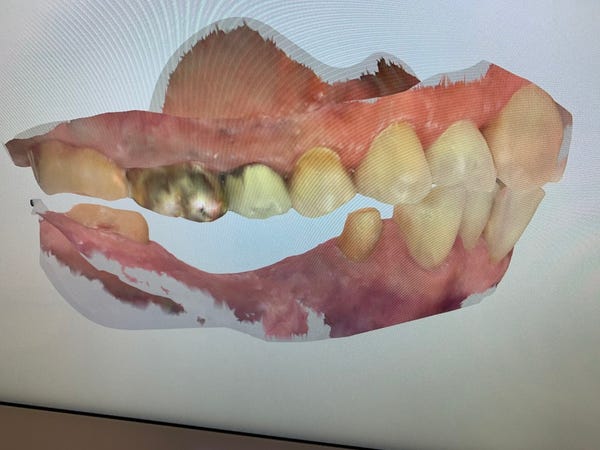3D printed dental bridges, crowns, and implants are the ultimate in one-off production in manufacturing.
May 3, 2021

As 3D printing exploded in growth over the past decade. One of the industries where it sank quick roots was dentistry. A report from SmartTech Analysis estimates that revenues from 3D printers and related software, materials, and services sold to dentists and dental labs will reach $3.7 billion this year.
This year, there’s 3D printing in my mouth. Recently, I needed to replace an aging dental bridge. The traditional porcelain-and-metal contraption that served me for years was beginning to chip away. When it came time to create the new bridge, my dentist, Dr. Ryan Shepherd, at Uptown Dental Associates in Albuquerque, N.M., told me he would be using 3D printing – it’s stronger, less expensive, and it doesn’t take as long to produce. His assistant then put a scanning wand in my mouth and began taking images.

Like many dental practices, Dr. Shepherd has been using 3D printing for nearly a decade. “We started using 3D printing in 2012, though it’s been around longer. We used it for isolated cases at first. We used it if it didn’t matter how the result looked since the early versions couldn’t be polished,” said Dr. Shepherd. “Over the last few years, the materials have progressed. They had a pretty material, but it wasn’t quite strong enough for the back of the mouth, for someone with a strong bite. Now, the materials have made so much progress you can use them anywhere in the mouth.”
I was surprised to find out Dr. Shepherd had switched almost entirely to 3D printing for bridges, implants, and crowns. “We use 3D printing for 80% of our cases now. 90% in with some of our work. In most cities 3D printing dental work has become standard,” said Dr. Shepherd. “In rural areas, it is probably is not as prevalent. Also, older dentists don’t use it as much. It wasn’t something they were taught.”

3D Printed Dental Work is Speedy and Inexpensive
One of the attractive features of 3D printed dental work is the precision and the improved turnaround. “It’s the best solution for accuracy. The speed depends on the lab,” said Dr. Shepherd. “It doesn’t take them more than about two days. A well-equipped lab could do it quickly. If you had in-office equipment, it could be done in a few hours.”
Dr. Shepherd has become enamored with the results of the 3D printed material, but he declined the opportunity to buy the equipment for his practice. “I’m not interested in owning 3D printing. You could have one in the office, but it costs $100,000, and you need a team member who does just that,” said Dr. Shepherd. “We work with a lab just across the street and one in Florida.”
Another benefit of the additive process was its relatively low cost. “It keeps costs down significantly. Using traditional porcelain fused on metal is twice as expensive,” said Dr. Shepherd. “Plus, the 3D printed stuff is stronger. 50 years ago, gold was the gold standard. Now I’m thrilled with the 3D printed ceramic.”
To get an image that the lab can use to create the dental work, the dental assistant uses a 3D wand. “We switched to the 3D scanner about a year and a half ago,” said Dr. Shepherd. “The software is not terribly difficult, There were headaches at first. Nobody had trained with it at school. For a month there was a learning curve, but after a few weeks, our folks were proficient. And there’s less gagging for the patients.”
Emailing the Files to the Lab
Once the scanning is complete, the images are sent to the lab across the street, in this case, Cosmetic Dental Arts in Albuquerque. “The doctor’s office uses an iTero digital scanner. They email us the files. We use that to design the bridge,” Mike Sumner, owner of the lab told Design News. “We have iTero programs, and we use those to design the bridge on the screen. Then we mill it right here in-house.”
Sumner noted that he switched from porcelain, gold, and metal as his dental customers started to ask for the lower-cost 3D printed process. “Previously we used porcelain and metal. We turned to 3D printing out of necessity in 2006,” said Sumner. “The doctors demanded a lower price. Gold was too expensive. Zirconia is the material we use now. It’s great for durability. If you do a bridge, they’re near indestructible, and they don’t chip. This isn’t an experiment any longer. It’s state of the art.”
Rob Spiegel has covered manufacturing for 19 years, 17 of them for Design News. Other topics he has covered include automation, supply chain technology, alternative energy, and cybersecurity. For 10 years, he was the owner and publisher of the food magazine Chile Pepper.
About the Author(s)
You May Also Like





